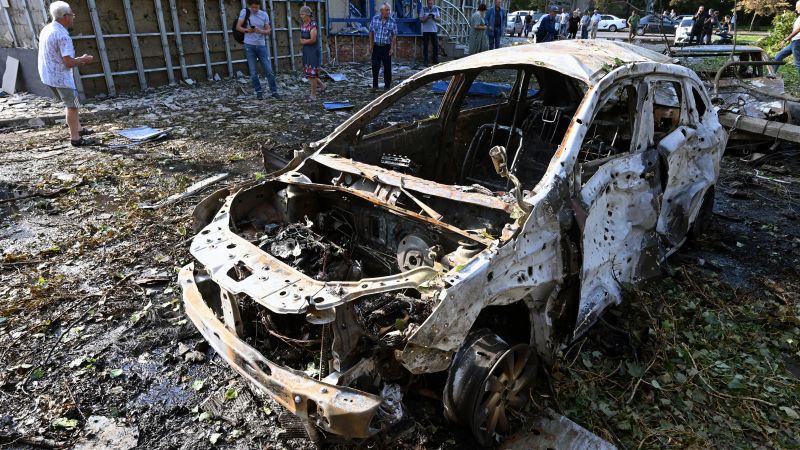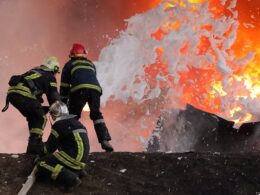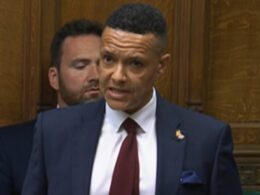CNN
—
Russia is scrambling to shore up its defenses more than a week into Ukraine’s shock, lightning attack across the border on the southern Kursk region.
US officials told CNN that Russia has diverted thousands of troops from occupied territory inside Ukraine to counter the threat. Russia’s President Vladimir Putin has had to bring in conscripts, backpeddling on a promise he made not to use them on the frontline.
A sizeable trench has been dug across countryside near the town of Selektsionnyi, around 45 kilometers (about 28 miles) from the border, in Kursk, satellite imagery showed. Online job adverts for trench diggers have emerged. “Payment every week,” promised one.
Experts told CNN that Ukraine’s bold gambit to breach Russia’s border, planned in complete secrecy, had stunned even Kyiv’s closest allies, including the United States, shifting the playing field of a more than two-year-old war.
But after months on the backfoot, losing ground in grinding battles in their own territory, just how were the Ukrainians able to catch Moscow by surprise and penetrate the Russian homeland?
First: superb operational security. Nothing about the operation leaked. Based on videos from the ground and satellite imagery of their advance, the troop movements almost seemed like an exercise or a defensive reinforcement.
“[Ukraine has] demonstrated that they can pull off such a secretive and significant operation successfully, they can penetrate Russian territory so this is no longer the red line, and they … are still very much committed to fight for their country, that there is no such thing as war fatigue, and they’re willing to take these, in a way, extreme measures for the sake of defending their country,” Natia Seskuria, an associate fellow at the UK’s Royal United Services Institute for Defense and Security Studies (RUSI), told CNN.
The force was built up under cover of thick summer foliage along the rural roads of Sumy region, in northeast Ukraine. Experienced, battle-hardened units were brought up or diverted from other areas. Units such as the 82nd Air Assault Brigade, which had until recently been fighting in nearby Kharkiv region, were pulled into the mission to breach the border, according to multiple videos and social media accounts.
Among the detailed preparations was precise intelligence on the readiness and ability of Russian units on the border, and the number of obstacles that lay ahead, from minefields to tank traps. There weren’t many.
Ukrainian forces also used detailed knowledge of the geography to launch the attack, using forest belts for cover and roads for speed. It was only in the last days before the incursion began that commanders were briefed on the mission.
“The key, in terms of Ukraine’s success, [was that] they managed to penetrate Russian territory quite easily with little to no resistance. It was a complete surprise for the Russians, and it demonstrates that Russian intelligence services really failed to foresee any sort of Ukrainian incursion into the region,” said Seskuria.
Having established weak points in Russian defenses, the first Ukrainian units stormed into Kursk on the afternoon of August 6.
Videos on social media, which were geolocated by CNN, appear to show dozens of Russian soldiers immediately surrendering at the heavily damaged border crossing south-west of the town of Sudzha, located 105 kilometers (65 miles) southwest of the city of Kursk.

Serhii Sternenko, a Ukrainian vlogger who shared the video on his Twitter and Telegram channels, said it showed at least 22 Russian soldiers “surrender” in the Kursk region. CNN was unable to confirm the identity of those shown in the footage.
Ukrainian President Volodymyr Zelensky said on Thursday that Ukrainian forces had taken control of Sudzha – the first official confirmation that the troops, which have been in the town since last Wednesday, had captured it.
The town is an important transit point for gas supples from Russia to Europe via Ukraine. Satellite images showed a gas terminal at a nearby border point in ruins.
In their charge across the border, Ukrainians have used fast, resilient western-made armored vehicles: Strykers and Marders. Small mobile groups of special forces swiftly fanned out to dozens of locations as the Russian military scrambled to assess the strength of the assault.
Key to their success: air defenses and supporting artillery, as well as jamming to prevent the Russian military from communicating. Thermal protection for their body armor also helped soldiers evade heat-detecting drones.
Within hours of crossing the border, the Ukrainians were close to Sudzha. Many of its residents were sent scrambling on hair-raising escapes, some cursing the Russian military for abandoning them.
As the operation unfolded, Ukrainian soldiers posted video of themselves in front of village signs before vanishing, part of a parallel campaign of psychological warfare.
CNN geolocated numerous videos showing Ukrainian forces posing in front of road signs and taking down Russian flags at village halls across the Kursk region, including in Porozovsky, Plekhovo, Sverdlikovo, Guyevo and Sudzha.
“I think that has a great value in terms of information warfare because these images, videos that we see … that is a really good morale boost for Ukrainians,” said RUSI’s Seskuria.
Rather than confront Russian units head-on, advanced Ukrainian units bypassed them, cutting them off. The Russian military command struggled to keep up with where the threat was emanating from.
At the same time, the Ukrainians trained their attention on Russian reinforcements, wiping out one convoy of 14 Russian military vehicles near Rylsk with a missile attack. Video shared on social media, which CNN geolocated to the village of Oktyabr’skoe in the Kursk region, showed the dead bodies of Russian soldiers in destroyed and burned-out trucks along a section of road.
The head of Ukraine’s armed forces, Oleksandr Syrskyi, said Thursday that Ukrainian forces had captured 1,150 square kilometers (about 444 square miles) of territory and 82 settlements since the start of the surprise incursion.
More than a week after the incursion began, the Ukrainians were still probing for weaknesses, consolidating their hold on a band of territory 35 kilometers (about 22 miles) deep – even providing Russian civilians with emergency food aid.
Seskuria told CNN that Ukraine’s incursion is partly a “self-defense measure … because Kursk region, due to its location, has been used many times to launch missiles on Ukrainian territory.”
“[Ukraine’s] strategic aim would be to divert Russian forces from offensive operations in the Donetsk oblast, where Russians have been making some advances in the recent months… that would be an obvious intention, to ease the military pressure in Ukraine.”
Seskuria added that Ukraine’s recent activity might provide Ukraine with “a better negotiating position when it comes to any sort of peace talks in the future.” Indeed Mykhailo Podolyak, an aide to Zelensky, said the incursion was aimed at persuading Russia to enter a “fair negotiation process.”
Russian military bloggers are apoplectic about the lack of readiness and the slow response to the incursion.
The Russian Defense Ministry insisted this week it was repelling Ukrainian advances and taking prisoners, but Russia’s reinforcements were struggling to retake ground, outmaneuvered and hit with missiles and artillery.
Can Kasapoğlu, a defense analyst at the Hudson Institute, a think tank based in Washington, DC, told CNN he did not foresee a Ukrainian withdrawal anytime soon.
“The offensive is culminating, and the battleground is stabilizing. Nonetheless, the Ukrainian military has already secured operational depth. If they can set robust defensive positions … they can stay inside Russian territory for a long time,” he said.
Kursk would be Ukraine’s “crown jewel” when negotiating an end to the conflict, Kasapoğlu added, if Kyiv manages to hold on to the seized territory.
Lizzy Yee, Paul Murphy, Avery Schmitz and Isaac Yee contributed reporting.










